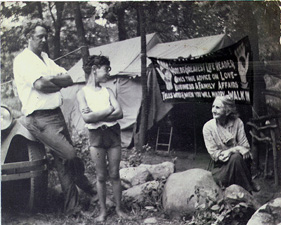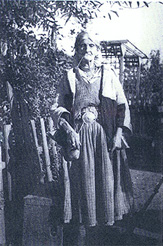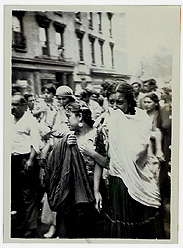"Gypsies" in the United States
Several groups, all known to
outsiders as "Gypsies," live today in the United States. In their
native languages, each of the groups refers to itself by a specific name,
but all translate their self-designations as  "Gypsy" when
speaking English. Each had its own cultural, linguistic, and historical
tradition before coming to this country, and each maintains social distance
from the others.
"Gypsy" when
speaking English. Each had its own cultural, linguistic, and historical
tradition before coming to this country, and each maintains social distance
from the others.
Rom
The Rom arrived in the United States from Serbia, Russia and Austria-Hungary beginning in the 1880's, part of the larger wave of immigration from southern and eastern Europe in the late 19th and early 20th centuries. Primary immigration ended, for the most part, in 1914, with the beginning of the First World War and subsequent tightening of immigration restrictions (Salo and Salo 1986). Many people in this group specialized in coppersmith work, mainly the repair and retinning of industrial equipment used in bakeries, laundries, confectioneries, and other businesses. The Rom, too, developed the fortune-telling business in urban areas.
 Two subgroups of the Rom, the
Kalderash ("coppersmith") and Machwaya ("natives of
Machva," a county in Serbia) appear in the photographs in Carlos de
Wendler-Funaro's collection. De Wendler-Funaro identified some, but not
all, Kalderash as "Russian Gypsies." Another group he identified
as "Russian Gypsies" seem to be the Rusniakuria ("Ruthenians"),
musicians and singers who settled in New York.
Two subgroups of the Rom, the
Kalderash ("coppersmith") and Machwaya ("natives of
Machva," a county in Serbia) appear in the photographs in Carlos de
Wendler-Funaro's collection. De Wendler-Funaro identified some, but not
all, Kalderash as "Russian Gypsies." Another group he identified
as "Russian Gypsies" seem to be the Rusniakuria ("Ruthenians"),
musicians and singers who settled in New York.
Ludar
 The Ludar, or "Romanian
Gypsies," also came to the United States during the great immigration
from southern and eastern Europe between 1880 and 1914. Most of the Ludar
came from northwestern Bosnia. Upon their arrival in the United States they
specialized as animal trainers and showpeople, and indeed passenger manifests
show bears and monkeys as a major part of their baggage. Most of de Wendler-Funaro's
photographs of this group were taken in Maspeth, a section of the borough
of Queens in New York City, where the Ludar created a "village"
of homemade shacks that existed from about 1925 to 1939, when it was razed.
A similar settlement stood in the Chicago suburbs during the same period.
The Ludar, or "Romanian
Gypsies," also came to the United States during the great immigration
from southern and eastern Europe between 1880 and 1914. Most of the Ludar
came from northwestern Bosnia. Upon their arrival in the United States they
specialized as animal trainers and showpeople, and indeed passenger manifests
show bears and monkeys as a major part of their baggage. Most of de Wendler-Funaro's
photographs of this group were taken in Maspeth, a section of the borough
of Queens in New York City, where the Ludar created a "village"
of homemade shacks that existed from about 1925 to 1939, when it was razed.
A similar settlement stood in the Chicago suburbs during the same period.
Romnichels
The Romnichels, or English
Gypsies, began to come to the United States from England in 1850. Their
arrival coincided with an increase in the demand for draft horses in agriculture
and then in urbanization, and many Romnichels worked as  horse-traders. After
the rapid decline in the horse trade following the First World War, most
Romnichels relied on previously secondary enterprises, "basket-making,"
including the manufacture and sale of rustic furniture, and fortune-telling.
Horse and mule trading continued to some extent in southern states where
poverty and terrain slowed the adoption of tractor power (Salo and Salo
1982).
horse-traders. After
the rapid decline in the horse trade following the First World War, most
Romnichels relied on previously secondary enterprises, "basket-making,"
including the manufacture and sale of rustic furniture, and fortune-telling.
Horse and mule trading continued to some extent in southern states where
poverty and terrain slowed the adoption of tractor power (Salo and Salo
1982).
 "Black Dutch"
"Black Dutch"
Gypsies from Germany, whom de Wendler-Funaro refers to as Chikkeners (Pennsylvania German, from the German Zigeuner), sometimes refer to themselves as "Black Dutch." They are few in number and claim to have largely assimilated into Romnichel culture. They are represented in de Wendler-Funaro's photographs by a few portraits of one old man and briefly referred to in the manuscript "In Search of the Last Caravan."
Hungarian Gypsies
Hungarian musicians also came to this country with the eastern European immigration. In the United States they continued as musicians to the Hungarian and Slovak immigrant settlements.
VIEW WENDLER-FUNARO'S BIOGRAPHICAL SKETCH || CREDITS || RETURN HOME